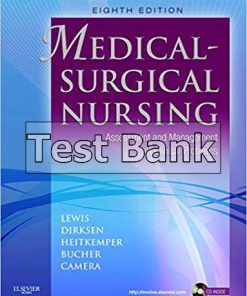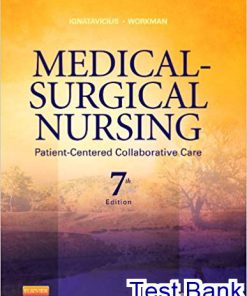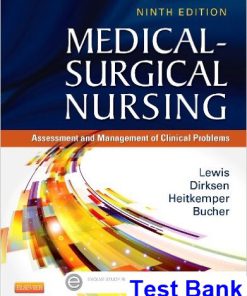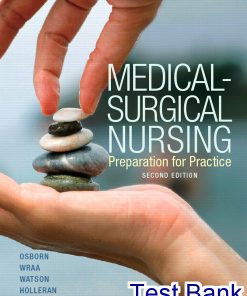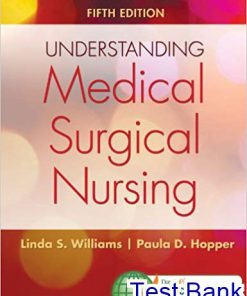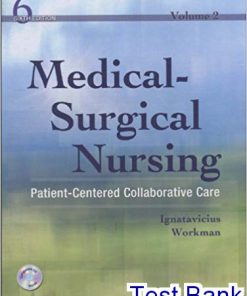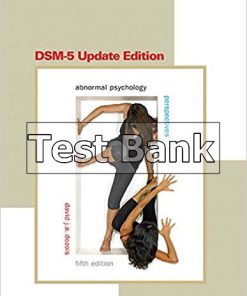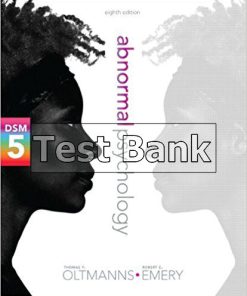Brunner and Suddarths Textbook of Medical Surgical Nursing 12th Edition Smeltzer Test Bank
$26.50$50.00 (-47%)
Brunner and Suddarths Textbook of Medical Surgical Nursing 12th Edition Smeltzer Test Bank.
You may also like
This is completed downloadable of Brunner and Suddarths Textbook of Medical Surgical Nursing 12th Edition Smeltzer Test Bank
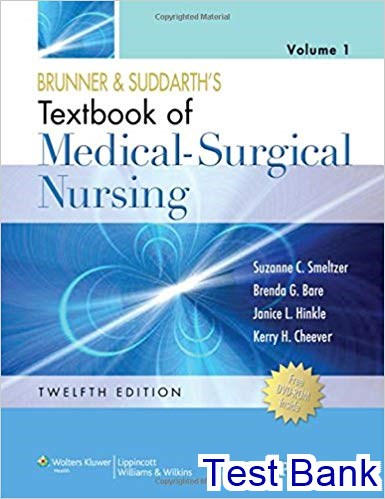
Product Details:
- ISBN-10 : 0781785898
- ISBN-13 : 978-0781785891
- Author:
Preparing students for successful NCLEX results and strong futures as nurses in today’s world.
Now in its 12th edition, Brunner and Suddarth’s Textbook of Medical-Surgical Nursing is designed to assist nurses in preparing for their roles and responsibilities in the medical-surgical setting and for success on the NCLEX. In the latest edition, the resource suite is complete with a robust set of premium and included ancillaries such as simulation support, adaptive testing, and a variety of digital resources helping prepare today’s students for success.
This leading textbook focuses on physiological, pathophysiological, and psychosocial concepts as they relate to nursing care. Brunner is known for its strong Nursing Process focus and its readability. This edition retains these strengths and incorporates enhanced visual appeal and better portability for students.
Table of Content:
unit 1 Basic Concepts in Nursing
2(74)
Health Care Delivery and Nursing Practice
4(10)
The Health Care Industry and the Nursing Profession
5(1)
Nursing Defined
5(1)
The Patient/Client: Consumer of Nursing and Health Care
5(1)
Health Care in Transition
5(1)
Health, Wellness, and Health Promotion
6(1)
Health
6(1)
Wellness
6(1)
Health Promotion
6(1)
Influences on Health Care Delivery
6(3)
Population Demographics
7(1)
Changing Patterns of Disease
7(1)
Advances in Technology and Genetics
8(1)
Demand for Quality Health Care
8(1)
Alternative Health Care Delivery Systems
9(1)
Roles of the Nurse
9(1)
Practitioner Role
9(1)
Leadership Role
10(1)
Research Role
10(1)
Models of Nursing Care Delivery
10(1)
Community-Based Nursing and Community-Oriented/Public Health Nursing
10(1)
Expanded Nursing Roles
11(3)
Interdisciplinary Collaborative Practice
12(2)
Community-Based Nursing Practice
14(8)
Community-Based Care
15(1)
Home Health Care
15(4)
Nursing in the Home Setting
16(1)
Discharge Planning for Home Care
17(1)
Community Resources and Referrals
17(1)
Home Health Visits
17(2)
Other Community-Based Health Care Settings
19(3)
Ambulatory Settings
19(1)
Occupational Health Programs
19(1)
School Health Programs
20(1)
Community Nurse-Managed Centers
20(1)
Care for the Homeless
20(2)
Critical Thinking, Ethical Decision Making, and the Nursing Process
22(19)
Critical Thinking
23(2)
Rationality and Insight
23(1)
Components of Critical Thinking
23(1)
Critical Thinking in Nursing Practice
23(2)
Ethical Nursing Care
25(4)
Ethics Versus Morality
25(1)
Ethics Theories
25(1)
Approaches to Ethics
25(1)
Moral Situations
25(1)
Types of Ethical Problems in Nursing
26(2)
Preventive Ethics
28(1)
Ethical Decision Making
29(1)
The Nursing Process
29(12)
Definition
29(1)
Using the Nursing Process
30(11)
Health Education and Health Promotion
41(14)
Health Education Today
42(1)
Purpose of Health Education
42(1)
Adherence to the Therapeutic Regimen
42(1)
Gerontologic Considerations
43(1)
The Nature of Teaching and Learning
43(4)
Learning Readiness
43(2)
The Learning Environment
45(1)
Teaching Techniques
45(1)
Teaching Special Populations
45(2)
The Nursing Process in Patient Teaching
47(2)
Assessment
47(1)
Nursing Diagnosis
47(1)
Planning
48(1)
Implementation
48(1)
Evaluation
48(1)
Health Promotion
49(2)
Definition
49(1)
Health and Wellness
49(1)
Health Promotion Models
49(1)
Components of Health Promotion
50(1)
Health Promotion Throughout the Lifespan
51(2)
Adolescents
51(1)
Young and Middle-Aged Adults
51(1)
Gerontologic Considerations
52(1)
Nursing Implications
53(2)
Adult Health and Nutritional Assessment
55(21)
Considerations for Conducting a Health History and Physical Assessment
56(1)
The Role of the Nurse
56(1)
Communicating Effectively
56(1)
Ethical Use of History or Physical Examination Data
56(1)
Increasing Use of Technology
56(1)
Health History
57(7)
The Informant
57(1)
Components of the Health History
57(7)
Other Health History Formats
64(1)
Physical Assessment
64(3)
Examination Considerations
65(1)
Components of the Physical Examination
65(2)
Nutritional Assessment
67(6)
Lifespan Considerations
68(1)
Components of Nutritional Assessment
68(3)
Factors Influencing Nutritional Status in Various Situations
71(2)
Analysis of Nutritional Status
73(1)
Assessment in the Home and Community
73(3)
unit 2 Biophysical and Psychosocial Concepts in Nursing Practice
76(152)
Homeostasis, Stress, and Adaptation
78(18)
Fundamental Concepts
79(1)
Steady State
79(1)
Stress and Adaptation
79(1)
Overview of Stress
80(5)
Types of Stressors
80(1)
Stress as a Stimulus for Disease
80(1)
Psychological Responses to Stress
80(1)
Physiologic Response to Stress
81(3)
Maladaptive Responses to Stress
84(1)
Indicators of Stress
84(1)
Nursing Implications
85(1)
Stress at the Cellular Level
85(6)
Control of the Steady State
86(1)
Cellular Adaptation
86(1)
Cellular Injury
87(2)
Cellular Response to Injury: Inflammation
89(1)
Cellular Healing
90(1)
Nursing Implications
91(1)
Stress Management: Nursing Interventions
91(5)
Promoting a Healthy Lifestyle
91(1)
Enhancing Coping Strategies
92(1)
Teaching Relaxation Techniques
92(1)
Educating About Stress Management
93(1)
Enhancing Social Support
93(1)
Recommending Support and Therapy Groups
93(3)
Individual and Family Considerations Related to Illness
96(12)
Holistic Approach to Health and Health Care
97(1)
The Brain and Physical and Emotional Health
97(1)
Mental Health and Emotional Distress
97(6)
Anxiety
98(1)
Posttraumatic Stress Disorder
99(1)
Depression
100(1)
Substance Abuse
101(2)
Family Health and Distress
103(1)
Nursing Implications
103(1)
Loss and Grief
104(1)
Nursing Implications
104(1)
Death and Dying
105(1)
Spirituality and Spiritual Distress
105(3)
Nursing Implications
105(3)
Perspectives in Transcultural Nursing
108(11)
Cultural Concepts
109(1)
Subcultures
109(1)
Minorities
110(1)
Transcultural Nursing
110(2)
Culturally Competent Nursing Care
110(1)
Cross-Cultural Communication
111(1)
Culturally Mediated Characteristics
112(3)
Space and Distance
113(1)
Eye Contact
113(1)
Time
113(1)
Touch
113(1)
Observance of Holidays
113(1)
Diet
114(1)
Biologic Variations
114(1)
Complementary and Alternative Therapies
114(1)
Causes of Illness
115(1)
Biomedical or Scientific
115(1)
Naturalistic or Holistic
115(1)
Magico-Religious
116(1)
Folk Healers
116(1)
Cultural Assessment
116(1)
Additional Cultural Considerations: Know Thyself
116(1)
Health Disparities
117(1)
The Future of Transcultural Nursing Care
117(2)
Genetics and Genomics Perspectives in Nursing
119(25)
Genomic Framework for Nursing Practice
120(1)
Integrating Genetic and Genomic Knowledge
121(6)
Genes and Their Role in Human Variation
121(3)
Inheritance Patterns
124(2)
Chromosomal Differences and Genetic Conditions
126(1)
Genetic and Genomic Technologies in Practice
127(5)
Genetic Testing
128(1)
Genetic Screening
128(1)
Testing and Screening for Adult-Onset Conditions
128(4)
Personalized Genomic Treatments
132(2)
Applications of Genetics and Genomics in Nursing Practice
134(7)
Genetics and Genomics in Health Assessment
134(3)
Genetic Counseling and Evaluation Services
137(4)
Ethical Issues
141(3)
Chronic Illness and Disability
144(22)
Overview of Chronicity
145(4)
Definition of Chronic Conditions
145(1)
Prevalence and Causes of Chronic Conditions
145(2)
Characteristics of Chronic Conditions
147(1)
Implications of Managing Chronic Conditions
148(1)
Phases of Chronic Conditions
148(1)
Nursing Care of Patients With Chronic Conditions
149(3)
Applying the Nursing Process Using the Phases of the Chronic Illness System
150(1)
Home and Community-Based Care
151(1)
Nursing Care for Special Populations With Chronic Illness
152(1)
Overview of Disability
152(3)
Definitions of Disability
152(1)
Prevalence of Disability
153(1)
Characteristics of Disability
153(2)
Federal Legislation
155(1)
Right of Access to Health Care
155(5)
Barriers to Health Care
157(3)
Federal Assistance Programs
160(1)
Nursing Care of Patients With Disabilities
160(6)
Nursing Considerations During Hospitalization
160(1)
Health Promotion and Prevention
161(1)
Significance of “People-First” Language
161(1)
Gerontologic Considerations
161(1)
Disability in Medical-Surgical Nursing Practice
162(1)
Home and Community-Based Care
162(4)
Principles and Practices of Rehabilitation
166(34)
Americans With Disabilities Act
168(1)
Patients’ Reactions to Disability
168(1)
The Rehabilitation Team
169(1)
Areas of Specialty Rehabilitation
169(1)
Assessment of Functional Ability
170(24)
Disability and Sexuality Issues
194(1)
Fatigue
194(1)
Complementary and Alternative Therapies
194(1)
Promoting Home and Community-Based Care
195(5)
Teaching Patients Self-Care
195(1)
Continuing Care
195(5)
Health Care of the Older Adult
200(28)
Overview of Aging
201(1)
Demographics of Aging
201(1)
Health Status of the Older Adult
201(1)
Nursing Care of the Older Adult
202(1)
Theories of Aging
202(1)
Age-Related Changes
202(11)
Physical Aspects of Aging
203(6)
Psychosocial Aspects of Aging
209(2)
Cognitive Aspects of Aging
211(1)
Pharmacologic Aspects of Aging
212(1)
Mental Health Problems in the Older Adult
213(7)
Depression
213(1)
Delirium
214(3)
Dementia
217(3)
Geriatric Syndromes
220(2)
Impaired Mobility
220(1)
Dizziness
220(1)
Falls and Falling
220(1)
Urinary Incontinence
221(1)
Increased Susceptibility to Infection
221(1)
Altered Pain and Febrile Responses
222(1)
Altered Emotional Impact
222(1)
Altered Systemic Response
222(1)
Other Aspects of Health Care of the Older Adult
222(2)
Elder Neglect and Abuse
222(1)
Social Services
223(1)
Health Care Costs of Aging
223(1)
Home Health Care
223(1)
Hospice Services
224(1)
Aging with a Disability
224(1)
Ethical and Legal Issues Affecting the Older Adult
224(4)
unit 3 Concepts and Challenges in Patient Management
228(194)
Pain Management
230(33)
Importance of Pain Assessment and Management
231(1)
Types of Pain
231(1)
Classic Categories of Pain
231(1)
Pain Classified by Location
232(1)
Pain Classified by Etiology
232(1)
Harmful Effects of Pain
232(1)
Effects of Acute Pain
232(1)
Effects of Chronic Pain
232(1)
Pathophysiology of Pain
232(3)
Nociceptors
232(2)
Peripheral Nervous System
234(1)
Central Nervous System
234(1)
Gate Control Theory
235(1)
Factors Influencing Pain Response
235(2)
Past Experience
236(1)
Anxiety and Depression
236(1)
Culture
236(1)
Gerontologic Considerations
236(1)
Gender
237(1)
The Nurse’s Role in Assessment and Care of Patients with Pain
237(5)
Assessment
237(3)
Nursing Care
240(2)
Pain Management Strategies
242(1)
Premedication Assessment
242(17)
Agents Used to Treat Pain
244(4)
Approaches for Using Analgesic Agents
248(3)
Routes of Administration
251(3)
Placebo Effect
254(1)
Gerontologic Considerations
254(1)
Promoting Home and Community-Based Care
255(1)
Activities to Promote Comfort
256(2)
Neurologic and Neurosurgical Approaches to Pain Management
258(1)
Evaluating Pain Management Strategies
259(4)
Fluid and Electrolytes: Balance and Disturbance
263(49)
Fundamental Concepts
264(9)
Hypervolemia
273(2)
Sodium Imbalances
275(5)
Potassium Imbalances
280(4)
Calcium Imbalances
284(4)
Magnesium Imbalances
288(2)
Phosphorus Imbalances
290(2)
Chloride Imbalances
292(2)
Acute and Chronic Metabolic Acidosis (Base Bicarbonate Deficit)
294(1)
Acute and Chronic Metabolic Alkalosis (Base Bicarbonate Excess)
295(1)
Acute and Chronic Respiratory Acidosis (Carbonic Acid Excess)
296(1)
Acute and Chronic Respiratory Alkalosis (Carbonic Acid Deficit)
296(1)
Mixed Acid-Base Disorders
297(1)
Parenteral Fluid Therapy
298(14)
Shock and Multiple Organ Dysfunction Syndrome
312(24)
Overview of Shock
313(1)
Stages of Shock
314(6)
General Management Strategies in Shock
320(2)
Hypovolemic Shock
322(3)
Cardiogenic Shock
325(2)
Circulatory Shock
327(5)
Multiple Organ Dysfunction Syndrome
332(1)
Promoting Home and Community-Based Care
333(3)
Oncology: Nursing Management in Cancer Care
336(59)
Epidemiology of Cancer
337(1)
Pathophysiology of the Malignant Process
338(4)
Detection and Prevention of Cancer
342(3)
Diagnosis of Cancer
345(1)
Tumor Staging and Grading
345(1)
Management of Cancer
346(20)
Nursing Care of Patients With Cancer
366(25)
Cancer Survivorship
391(4)
End-of-Life Care
395(27)
Nursing and End-of-Life Care
396(2)
Settings for End-of-Life Care
398(4)
Nursing Care of Terminally Ill Patients
402(12)
Nursing Care of Patients Who Are Close to Death
414(4)
Coping With Death and Dying: Professional Caregiver Issues
418(4)
unit 4 Perioperative Concepts and Nursing Management
422(62)
Preoperative Nursing Management
424(18)
Perioperative Nursing
425(1)
Advances in Technology and Anesthesia
425(1)
Surgical Classifications
425(1)
Preadmission Testing
425(1)
Special Considerations During the Perioperative Period
425(3)
Informed Consent
428(1)
Preoperative Assessment
428(6)
General Preoperative Nursing Interventions
434(4)
Immediate Preoperative Nursing Interventions
438(1)
Expected Patient Outcomes
439(3)
Intraoperative Nursing Management
442(19)
The Surgical Team
443(3)
The Surgical Environment
446(2)
The Surgical Experience
448(7)
Potential Intraoperative Complications
455(6)
Postoperative Nursing Management
461(23)
Care of the Patient in the Postanesthesia Care Unit
462(6)
Care of the Hospitalized Postoperative Patient
468(16)
unit 5 Gas Exchange and Respiratory Function
484(198)
Assessment of Respiratory Function
486(31)
Anatomic and Physiologic Overview
487(8)
Assessment
495(12)
Diagnostic Evaluation
507(10)
Management of Patients With Upper Respiratory Tract Disorders
517(34)
Rhinitis
518(2)
Viral Rhinitis (Common Cold)
520(1)
Rhinosinusitis
521(5)
Pharyngitis
526(2)
Tonsillitis and Adenoiditis
528(1)
Peritonsillar Abscess
529(1)
Laryngitis
530(4)
Epistaxis (Nosebleed)
534(1)
Nasal Obstruction
535(1)
Fractures of the Nose
536(1)
Laryngeal Obstruction
537(1)
Cancer of the Larynx
537(14)
Management of Patients With Chest and Lower Respiratory Tract Disorders
551(50)
Pneumonia
554(11)
Aspiration
565(2)
Severe Acute Respiratory Syndrome
567(1)
Pulmonary Tuberculosis
567(5)
Lung Abscess
572(1)
Pleurisy
573(1)
Pleural Effusion
574(1)
Empyema
575(1)
Pulmonary Edema
576(1)
Acute Respiratory Failure
576(1)
Acute Respiratory Distress Syndrome
577(2)
Pulmonary Arterial Hypertension
579(2)
Pulmonary Heart Disease (Cor Pulmonale)
581(1)
Pulmonary Embolism
582(5)
Sarcoidosis
587(1)
Lung Cancer (Bronchogenic Carcinoma)
588(4)
Tumors of the Mediastinum
592(1)
Blunt Trauma
593(3)
Penetrating Trauma: Gunshot and Stab Wounds
596(1)
Prieumothorax
596(3)
Cardiac Tamponade
599(1)
Subcutaneous Emphysema
599(2)
Management of Patients With Chronic Pulmonary Disease
601(34)
Chronic Obstructive Pulmonary Disease
602(12)
Bronchiectasis
614(6)
Asthma
620(10)
Status Asthmaticus
630(1)
Cystic Fibrosis
631(4)
Respiratory Care Modalities
635(47)
Incentive Spirometry (Sustained Maximal Inspiration)
640(1)
Mini-Nebulizer Therapy
641(1)
Intermittent Positive-Pressure Breathing
642(1)
Chest Physiotherapy
642(3)
Emergency Management of Upper Airway Obstruction
645(1)
Endotracheal Intubation
646(2)
Tracheostomy
648(3)
Mechanical Ventilation
651(13)
Preoperative Management
664(2)
Postoperative Management
666(16)
unit 6 Cardiovascular, Circulatory, and Hematologic Function
682(294)
Assessment of Cardiovascular Function
684(36)
Anatomic and Physiologic Overview
685(6)
Anatomy of the Heart
685(2)
Function of the Heart
687(3)
Gerontologic Considerations
690(1)
Gender Considerations
690(1)
Assessment of the Cardiovascular System
691(14)
Health History
691(6)
Physical Assessment
697(8)
Diagnostic Evaluation
705(15)
Laboratory Tests
705(2)
Chest X-Ray and Fluoroscopy
707(1)
Electrocardiography
707(2)
Cardiac Stress Testing
709(1)
Echocardiography
710(1)
Radionuclide Imaging
711(2)
Cardiac Catheterization
713(2)
Electrophysiologic Testing
715(1)
Hemodynamic Monitoring
715(5)
Management of Patients With Dysrhythmias and Conduction Problems
720(35)
Dysrhythmias
721(20)
Normal Electrical Conduction
721(1)
The Electrocardiogram
721(4)
Analyzing the Electrocardiogram Rhythm Strip
725(16)
Adjunctive Modalities and Management
741(14)
Cardioversion and Defibrillation
741(2)
Pacemaker Therapy
743(4)
Implantable Cardioverter Defibrillator
747(4)
Electrophysiologic Studies
751(1)
Cardiac Conduction Surgery
752(3)
Management of Patients With Coronary Vascular Disorders
755(42)
Coronary Atherosclerosis
756(6)
Angina Pectoris
762(6)
Acute Coronary Syndrome and Myocardial Infarction
768(11)
Surgical Procedures: Coronary Artery Revascularization
779(18)
Management of Patients With Structural, Infectious, and Inflammatory Cardiac Disorders
797(26)
Mitral Valve Prolapse
798(1)
Mitral Regurgitation
799(1)
Mitral Stenosis
800(1)
Aortic Regurgitation
801(1)
Aortic Stenosis
801(1)
Nursing Management: Valvular Heart Disorders
802(2)
Valve Replacement
804(2)
Nursing Management: Valvuloplasty and Replacement
806(1)
Septal Defects
807(1)
Cardiomyopathy
807(7)
Rheumatic Endocarditis
814(1)
Infective Endocarditis
815(2)
Myocarditis
817(1)
Pericarditis
818(5)
Management of Patients With Complications From Heart Disease
823(24)
Cardiac Hemodynamics
824(1)
Chronic Heart Failure
825(14)
Pulmonary Edema
839(2)
Thromboembolism
841(1)
Pericardial Effusion and Cardiac Tamponade
842(1)
Cardiac Arrest
843(4)
Assessment and Management of Patients With Vascular Disorders and Problems of Peripheral Circulation
847(42)
Anatomic and Physiologic Overview
848(4)
Assessment
852(1)
Diagnostic Evaluation
852(11)
Peripheral Arterial Occlusive Disease
863(3)
Upper Extremity Arterial Occlusive Disease
866(1)
Thromboangiitis Obliterans (Buerger’s Disease)
866(1)
Aortoiliac Disease
867(1)
Aneurysms
868(3)
Other Aneurysms
871(1)
Dissecting Aorta
871(1)
Arterial Embolism and Arterial Thrombosis
872(1)
Raynaud’s Phenomenon
873(7)
Chronic Venous Insufficiency/Postthrombotic Syndrome
880(1)
Leg Ulcers
881(3)
Varicose Veins
884(2)
Lymphangitis and Lymphadenitis
886(1)
Lymphedema and Elephantiasis
886(3)
Assessment and Management of Patients With Hypertension
889(14)
Hypertension
890(10)
Pathophysiology
890(1)
Clinical Manifestations
891(1)
Assessment and Diagnostic Findings
892(1)
Medical Management
892(8)
Hypertensive Crises
900(3)
Assessment and Management of Patients With Hematologic Disorders
903(73)
Assessment and Diagnostic Evaluation
909(5)
Hypoproliferative Anemias
914(6)
Hemolytic Anemias
920(7)
Polycythemia Vera
927(1)
Secondary Polycythemia
928(1)
Neutropenia
929(1)
Lymphopenia
930(3)
Acute Myeloid Leukemia
933(1)
Chronic Myeloid Leukemia
934(1)
Acute Lymphocytic Leukemia
935(1)
Chronic Lymphocytic Leukemia
936(5)
Hodgkin Lymphoma
941(2)
Non-Hodgkin Lymphomas
943(4)
Primary Thrombocythemia
947(1)
Secondary Thrombocytosis
948(1)
Thrombocytopenia
949(1)
Idiopathic Thrombocytopenic Purpura
950(1)
Platelet Defects
951(1)
Hemophilia
951(3)
Von Willebrand’s Disease
954(1)
Vitamin K Deficiency
954(1)
Complications of Anticoagulant Therapy
955(1)
Disseminated Intravascular Coagulation
955(4)
Thrombotic Disorders
959(1)
Hyperhomocysteinemia
959(1)
Antithrombin Deficiency
959(1)
Protein C Deficiency
960(1)
Protein S Deficiency
960(1)
Activated Protein C Resistance and Factor V Leiden Mutation
960(1)
Acquired Thrombophilia
960(16)
unit 7 Digestive and Gastrointestinal Function
976(138)
Assessment of Digestive and Gastrointestinal Function
978(19)
Anatomic and Physiologic Overview
979(3)
Anatomy of the Gastrointestinal System
979(1)
Function of the Digestive System
980(2)
Gerontologic Considerations
982(1)
Assessment of the Gastrointestinal System
982(4)
Health History
982(2)
Physical Assessment
984(2)
Diagnostic Evaluation
986(11)
Serum Laboratory Studies
986(1)
Stool Tests
987(1)
Breath Tests
987(1)
Abdominal Ultrasonography
987(1)
DNA Testing
988(1)
Imaging Studies
988(2)
Endoscopic Procedures
990(4)
Manometry and Electrophysiologic Studies
994(1)
Gastric Analysis, Gastric Acid Stimulation Test, and pH Monitoring
995(1)
Laparoscopy (Peritoneoscopy)
995(2)
Management of Patients With Oral and Esophageal Disorders
997(24)
Dental Plaque and Caries
998(2)
Dentoalveolar Abscess or Periapical Abscess
1000(1)
Malocclusion
1001(1)
Temporomandibular Disorders
1002(1)
Jaw Disorders Requiring Surgical Management
1002(1)
Parotitis
1002(1)
Sialadenitis
1003(1)
Salivary Calculus (Sialolithiasis)
1003(1)
Neoplasms
1003(1)
Nursing Management of the Patient With Conditions of the Oral Cavity
1004(7)
Achalasia
1011(1)
Diffuse Esophageal Spasm
1011(1)
Hiatal Hernia
1012(1)
Diverticulum
1013(1)
Perforation
1013(1)
Foreign Bodies
1014(1)
Chemical Burns
1014(1)
Gastroesophageal Reflux Disease
1014(1)
Barrett’s Esophagus
1015(1)
Benign Tumors of the Esophagus
1015(2)
Cancer of the Esophagus
1017(4)
Gastrointestinal Intubation and Special Nutritional Modalities
1021(22)
Gastrointestinal Intubation
1022(9)
Tube Types
1022(1)
Nursing Management
1023(8)
Gastrostomy and Jejunostomy
1031(3)
Parenteral Nutrition
1034(9)
Establishing Positive Nitrogen Balance
1034(1)
Clinical Indications
1035(1)
Formulas
1035(1)
Initiating Therapy
1035(1)
Administration Methods
1035(2)
Discontinuing Parenteral Nutrition
1037(6)
Management of Patients With Gastric and Duodenal Disorders
1043(24)
Gastritis
1044(3)
Peptic Ulcer Disease
1047(8)
Morbid Obesity
1055(1)
Gastric Cancer
1056(4)
Gastric Surgery
1060(2)
Duodenal Tumors
1062(5)
Management of Patients With Intestinal and Rectal Disorders
1067(47)
Constipation
1068(2)
Diarrhea
1070(2)
Fecal Incontinence
1072(1)
Irritable Bowel Syndrome
1073(1)
Conditions of Malabsorption
1074(1)
Appendicitis
1075(2)
Diverticular Disease
1077(3)
Peritonitis
1080(2)
Types of Inflammatory Bowel Disease
1082(2)
Management of Chronic Inflammatory Bowel Disease
1084(13)
Small Bowel Obstruction
1097(1)
Large Bowel Obstruction
1098(1)
Colorectal Cancer
1098(9)
Polyps of the Colon and Rectum
1107(1)
Diseases
1108(2)
Nursing Management of Patients With Anorectal Conditions
1110(4)
unit 8 Metabolic and Endocrine Function
1114(176)
Assessment and Management of Patients With Hepatic Disorders
1116(53)
Assessment
1119(1)
Diagnostic Evaluation
1120(3)
Jaundice
1123(1)
Portal Hypertension
1123(1)
Ascites
1124(4)
Esophageal Varices
1128(5)
Hepatic Encephalopathy and Coma
1133(4)
Other Manifestations of Hepatic Dysfunction
1137(2)
Hepatitis A Virus
1139(2)
Hepatitis B Virus
1141(3)
Hepatitis C Virus
1144(1)
Hepatitis D Virus
1144(1)
Hepatitis E Virus
1145(1)
Hepatitis G Virus and GB Virus-C
1145(1)
Toxic Hepatitis
1145(1)
Drug-Induced Hepatitis
1145(13)
Primary Liver Tumors
1158(1)
Liver Metastases
1158(3)
Liver Transplantation
1161(4)
Liver Abscesses
1165(4)
Assessment and Management of Patients With Biliary Disorders
1169(27)
Cholecystitis
1171(1)
Cholelithiasis
1172(9)
Acute Pancreatitis
1181(4)
Chronic Pancreatitis
1185(5)
Pancreatic Cysts
1190(1)
Cancer of the Pancreas
1190(2)
Tumors of the Head of the Pancreas
1192(1)
Pancreatic Islet Tumors
1193(1)
Hyperinsulinism
1194(1)
Ulcerogenic Tumors
1194(2)
Assessment and Management of Patients With Diabetes Mellitus
1196(49)
Hypoglycemia (Insulin Reactions)
1222(3)
Diabetic Ketoacidosis
1225(2)
Hyperglycemic Hyperosmolar Nonketotic Syndrome
1227(3)
Macrovascular Complications
1230(1)
Microvascular Complications
1231(4)
Diabetic Neuropathies
1235(1)
Foot and Leg Problems
1236(2)
Management of Hospitalized Patients With Diabetes
1238(7)
Assessment and Management of Patients With Endocrine Disorders
1245(45)
Assessment
1248(1)
Diagnostic Evaluation
1249(1)
Pathophysiology
1250(1)
Specific Disorders of the Pituitary Gland
1251(2)
Anatomic and Physiologic Overview
1253(1)
Pathophysiology
1254(1)
Assessment and Diagnostic Findings
1254(2)
Specific Disorders of the Thyroid Gland
1256(16)
Specific Disorders of the Parathyroid Glands
1272(4)
Specific Disorders of the Adrenal Glands
1276(9)
Corticosteroid Therapy
1285(5)
unit 9 Urinary Tract Function
1290(104)
Assessment of Renal and Urinary Tract Function
1292(19)
Anatomic and Physiologic Overview
1293(1)
Anatomy of the Renal and Urinary Tract Systems
1293(6)
Function of the Renal and Urinary Tract Systems
1295(3)
Gerontologic Considerations
1298(1)
Assessment of the Renal and Urinary Tract Systems
1299(4)
Health History
1299(2)
Physical Assessment
1301(2)
Diagnostic Evaluation
1303(8)
Urinalysis and Urine Culture
1303(1)
Specific Gravity
1304(1)
Osmolality
1304(1)
Renal Function Tests
1304(2)
Diagnostic Imaging
1306(2)
Urologic Endoscopic Procedures
1308(1)
Biopsy
1309(2)
Management of Patients With Renal Disorders
1311(47)
Nephrosclerosis
1314(1)
Primary Glomerular Diseases
1314(4)
Polycystic Kidney Disease
1318(2)
Acute Renal Failure
1320(5)
Chronic Renal Failure (End-Stage Renal Disease)
1325(3)
Dialysis
1328(18)
Management of Patients Undergoing Kidney Surgery
1346(5)
Kidney Transplantation
1351(7)
Management of Patients With Urinary Disorders
1358(36)
Lower Urinary Tract Infections
1359(6)
Upper Urinary Tract Infections
1365(1)
Urinary Incontinence
1366(4)
Urinary Retention
1370(1)
Neurogenic Bladder
1371(1)
Catheterization
1372(9)
Cancer of the Bladder
1381(2)
Cutaneous Urinary Diversions
1383(4)
Continent Urinary Diversions
1387(1)
Other Urinary Diversion Procedures
1388(6)
unit 10 Reproductive Function
1394(148)
Assessment and Management of Female Physiologic Processes
1396(41)
Assessment
1400(9)
Diagnostic Evaluation
1409(4)
Menstruation
1413(1)
Perimenopause
1414(1)
Menopause
1414(3)
Menstrual Disorders
1417(4)
Dyspareunia
1421(1)
Contraception
1421(6)
Abortion
1427(2)
Infertility
1429(2)
Preconception/Periconception Health Care
1431(1)
Ectopic Pregnancy
1432(5)
Management of Patients With Female Reproductive Disorders
1437(34)
Candidiasis
1438(1)
Bacterial Vaginosis
1439(1)
Trichomoniasis
1440(1)
Gerontologic Considerations
1440(2)
Human Papillomavirus
1442(1)
Herpesvirus Type 2 Infection (Herpes Genitalis, Herpes Simplex Virus)
1442(3)
Endocervicitis and Cervicitis
1445(1)
Pelvic Infection (Pelvic Inflammatory Disease)
1446(1)
Human Immunodeficiency Virus Infection and Acquired Immunodeficiency Syndrome
1447(2)
Pelvic Organ Prolapse: Cystocele, Rectocele, Enterocele
1449(1)
Uterine Prolapse
1450(2)
Vulvar Cysts
1452(1)
Vulvar Dystrophy
1453(1)
Ovarian Cysts
1453(1)
Benign Tumors of the Uterus: Fibroids (Leiomyomas, Myomas)
1453(1)
Endometriosis
1454(2)
Chronic Pelvic Pain
1456(1)
Adenomyosis
1456(1)
Endometrial Hyperplasia
1456(1)
Cancer of the Cervix
1457(2)
Cancer of the Uterus (Endometrium)
1459(1)
Cancer of the Vulva
1459(3)
Cancer of the Vagina
1462(1)
Cancer of the Fallopian Tubes
1462(1)
Cancer of the Ovary
1462(2)
Hysterectomy
1464(3)
Radiation Therapy
1467(4)
Assessment and Management of Patients With Breast Disorders
1471(33)
Assessment
1472(1)
Diagnostic Evaluation
1473(7)
Fissure
1480(1)
Lactational Abscess
1480(1)
Cysts
1480(1)
Fibroadenomas
1480(1)
Benign Proliferative Breast Disease
1480(1)
Other Benign Conditions
1481(20)
Male Breast Cancer
1501(3)
Assessment and Management of Problems Related to Male Reproductive Processes
1504(38)
Assessment
1506(1)
Diagnostic Evaluation
1507(4)
Disorders of Ejaculation
1511(3)
Benign Prostatic Hyperplasia (Enlarged Prostate)
1514(2)
Cancer of the Prostate
1516(7)
The Patient Undergoing Prostate Surgery
1523(8)
Epididymitis
1531(1)
Testicular Torsion
1532(1)
Testicular Cancer
1532(3)
Hydrocele
1535(1)
Varicocele
1535(1)
Vasectomy
1535(2)
Cancer of the Penis
1537(1)
Priapism
1538(1)
Peyronie’s Disease
1538(1)
Urethral Stricture
1538(1)
Circumcision
1538(4)
unit 11 Immunologic Function
1542(116)
Assessment of Immune Function
1544(17)
Anatomic and Physiologic Overview
1545(8)
Anatomy of the Immune System
1545(1)
Function of the Immune System
1546(7)
Advances in Immunology
1553(1)
Genetic Engineering
1553(1)
Stem Cells
1553(1)
Assessment of the Immune System
1553(4)
Health History
1553(4)
Physical Assessment
1557(1)
Diagnostic Evaluation
1557(4)
Nursing Management
1558(3)
Management of Patients With Immunodeficiency
1561(12)
Phagocytic Dysfunction
1562(2)
B-Cell Deficiencies
1564(1)
T-Cell Deficiencies
1565(2)
Combined B-Cell and T-Cell Deficiencies
1567(2)
Deficiencies of the Complement System
1569(4)
Management of Patients With HIV Infection and AIDS
1573(33)
Epidemiology
1574(1)
HIV Transmission
1574(1)
Gerontologic Considerations
1575(1)
Prevention of HIV Infection
1575(2)
Transmission to Health Care Providers
1577(1)
Pathophysiology
1577(2)
Stages of HIV Disease
1579(1)
Assessment and Diagnostic Findings in HIV Infection
1580(2)
Treatment of HIV Infection
1582(4)
Clinical Manifestations
1586(4)
Medical Management
1590(2)
Complementary and Alternative Modalities
1592(1)
Supportive Care
1593(13)
Assessment and Management of Patients With Allergic Disorders
1606(25)
Assessment
1609(1)
Diagnostic Evaluation
1609(5)
Anaphylaxis
1614(2)
Allergic Rhinitis
1616(7)
Contact Dermatitis
1623(1)
Atopic Dermatitis
1623(1)
Dermatitis Medicamentosa (Drug Reactions)
1624(1)
Urticaria and Angioneurotic Edema
1625(1)
Hereditary Angioedema
1625(1)
Food Allergy
1625(1)
Latex Allergy
1626(5)
Assessment and Management of Patients With Rheumatic Disorders
1631(27)
Rheumatic Diseases
1632(11)
Diffuse Connective Tissue Diseases
1643(7)
Degenerative Joint Disease (Osteoarthritis)
1650(2)
Spondyloarthropathies
1652(1)
Metabolic and Endocrine Diseases Associated With Rheumatic Disorders
1653(1)
Fibromyalgia
1654(1)
Arthritis Associated With Infectious Organisms
1655(1)
Neoplasms and Neurovascular, Bone, and Extra-Articular Disorders
1655(1)
Miscellaneous Disorders
1655(3)
unit 12 Integumentary Function
1658(96)
Assessment of Integumentary Function
1660(1)
Anatomic and Physiologic Overview
1661(15)
Anatomy of the Skin, Hair, Nails, and Glands of the Skin
1661(3)
Functions of the Skin
1663(1)
Gerontologic Considerations
1664(1)
Assessment
1664(10)
Health History
1665(1)
Physical Assessment
1665(8)
Skin Consequences of Selected Systemic Diseases
1673(1)
Diagnostic Evaluation
1674(2)
Skin Biopsy
1674(1)
Immunofluorescence
1674(1)
Patch Testing
1674(1)
Skin Scrapings
1674(1)
Tzanck Smear
1674(1)
Wood’s Light Examination
1674(1)
Clinical Photographs
1674(2)
Management of Patients With Dermatologic Problems
1676(42)
Perineal and Perianal Pruritus
1683(1)
Hidradenitis Suppurativa
1684(1)
Seborrheic Dermatoses
1684(1)
Acne Vulgaris
1685(4)
Viral Skin Infections
1689(2)
Fungal (Mycotic) Skin Infections
1691(1)
Parasitic Skin Infestations
1692(6)
Exfoliative Dermatitis
1698(1)
Pemphigus
1699(1)
Bullous Pemphigoid
1700(1)
Dermatitis Herpetiformis
1700(2)
Toxic Epidermal Necrolysis and Stevens-Johnson Syndrome
1702(4)
Malignant Skin Tumors
1706(7)
Metastatic Skin Tumors
1713(1)
Kaposi’s Sarcoma
1713(1)
Wound Coverage: Grafts and Flaps
1713(2)
Cosmetic Procedures
1715(3)
Management of Patients With Burn Injury
1718(36)
Overview of Burn Injury
1719(6)
Incidence
1719(1)
Gerontologic Considerations
1719(1)
Outlook for Survival and Recovery
1720(1)
Severity
1720(1)
Pathophysiology
1721(4)
Management of Burn Injury
1725(26)
On-the-Scene Care
1725(1)
Medical Management
1725(3)
Nursing Management
1728(1)
Gerontologic Considerations
1729(1)
Medical Management
1729(13)
Nursing Management
1742(3)
Psychological Support
1745(2)
Abnormal Wound Healing
1747(4)
Outpatient Burn Care
1751(3)
unit 13 Sensorineural Function
1754(74)
Assessment and Management of Patients With Eye and Vision Disorders
1756(45)
Assessment
1760(2)
Diagnostic Evaluation
1762(2)
Low Vision and Blindness
1764(3)
Glaucoma
1767(5)
Cataracts
1772(4)
Keratoconus
1776(1)
Corneal Surgeries
1776(1)
Refractive Surgeries
1777(2)
Retinal Detachment
1779(1)
Retinal Vascular Disorders
1780(1)
Age-Related Macular Degeneration
1781(1)
Orbital Trauma
1782(2)
Ocular Trauma
1784(2)
Dry Eye Syndrome
1786(1)
Conjunctivitis
1787(3)
Uveitis
1790(1)
Orbital Cellulitis
1790(1)
Benign Tumors of the Eyelids
1791(1)
Benign Tumors of the Conjunctiva
1791(1)
Malignant Tumors of the Orbit
1791(1)
Malignant Tumors of the Eyelid
1791(1)
Malignant Tumors of the Conjunctiva
1791(1)
Malignant Tumors of the Globe
1791(1)
Enucleation
1792(2)
Cytomegalovirus Retinitis
1794(1)
Hypertension-Related Eye Changes
1794(7)
Assessment and Management of Patients With Hearing and Balance Disorders
1801(27)
Assessment
1804(2)
Diagnostic Evaluation
1806(5)
Foreign Bodies
1811(1)
External Otitis (Otitis Extema)
1812(1)
Malignant External Otitis
1812(1)
Masses of the External Ear
1813(1)
Gapping Earring Puncture
1813(1)
Acute Otitis Media
1813(1)
Serous Otitis Media
1814(1)
Chronic Otitis Media
1814(3)
Otosclerosis
1817(1)
Middle Ear Masses
1817(1)
Motion Sickness
1818(1)
Meniere’s Disease
1819(1)
Benign Paroxysmal Positional Vertigo
1820(1)
Tinnitus
1820(1)
Labyrinthitis
1820(3)
Ototoxicity
1823(1)
Acoustic Neuroma
1823(5)
unit 14 Neurologic Function
1828(178)
Assessment of Neurologic Function
1830(27)
Anatomic and Physiologic Overview
1831(10)
Cells of the Nervous System
1831(1)
Neurotransmitters
1831(1)
The Central Nervous System
1831(4)
The Peripheral Nervous System
1835(3)
Motor and Sensory Pathways of the Nervous System
1838(3)
Assessment of the Nervous System
1841(9)
Health History
1841(1)
Physical Assessment
1842(7)
Gerontologic Considerations
1849(1)
Diagnostic Evaluation
1850(1)
Computed Tomography Scanning
1850(1)
Magnetic Resonance Imaging
1850(1)
Positron Emission Tomography
1851(1)
Single Photon Emission Computed Tomography
1852(1)
Cerebral Angiography
1852(1)
Myelography
1852(1)
Noninvasive Carotid Flow Studies
1853(1)
Transcranial Doppler
1853(1)
Electroencephalography
1853(1)
Electromyography
1853(1)
Nerve Conduction Studies
1854(1)
Evoked Potential Studies
1854(1)
Lumbar Puncture and Examination of Cerebrospinal Fluid
1854(1)
Promoting Home and Community-Based Care
1855(2)
Management of Patients With Neurologic Dysfunction
1857(38)
Supratentorial and Infratentorial Approaches
1874(6)
Transsphenoidal Approach
1880(2)
The Epilepsies
1882(6)
Status Epilepticus
1888(7)
Management of Patients With Cerebrovascular Disorders
1895(23)
Ischemic Stroke
1896(14)
Pathophysiology
1896(1)
Clinical Manifestations
1897(2)
Assessment and Diagnostic Findings
1899(1)
Prevention
1899(1)
Medical Management
1900(10)
Hemorrhagic Stroke
1910(8)
Pathophysiology
1911(1)
Clinical Manifestations
1911(1)
Assessment and Diagnostic Findings
1912(1)
Prevention
1912(1)
Complications
1912(1)
Medical Management
1913(5)
Management of Patients With Neurologic Trauma
1918(31)
Head Injuries
1919(2)
Pathophysiology
1919(1)
Clinical Manifestations
1920(1)
Assessment and Diagnostic Findings
1920(1)
Gerontologic Considerations
1920(1)
Medical Management
1921(1)
Brain Injury
1921(12)
Types of Brain Injury
1921(2)
Management of Brain Injuries
1923(10)
Spinal Cord Injury
1933(16)
Pathophysiology
1933(1)
Clinical Manifestations
1934(1)
Assessment and Diagnostic Findings
1934(1)
Emergency Management
1934(1)
Medical Management (Acute Phase)
1934(4)
Management of Acute Complications of Spinal Cord Injury
1938(5)
Medical Management of Long-Term Complications of Spinal Cord Injury
1943(6)
Management of Patients With Neurologic Infections, Autoimmune Disorders, and Neuropathies
1949(26)
Meningitis
1950(2)
Brain Abscess
1952(1)
Herpes Simplex Virus Encephalitis
1953(1)
Arthropod-Borne Virus Encephalitis
1954(1)
Fungal Encephalitis
1954(1)
Creutzfeldt-Jakob and Variant Creutzfeldt-Jakob Disease
1955(1)
Multiple Sclerosis
1956(7)
Myasthenia Gravis
1963(3)
Guillain-Barre Syndrome
1966(4)
Trigeminal Neuralgia (Tic Douloureux)
1970(2)
Bell’s Palsy
1972(1)
Mononeuropathy
1973(2)
Management of Patients With Oncologic or Degenerative Neurologic Disorders
1975(31)
Primary Brain Tumors
1976(5)
Cerebral Metastases
1981(3)
Spinal Cord Tumors
1984(2)
Parkinson’s Disease
1986(6)
Huntington Disease
1992(1)
Alzheimer’s Disease
1993(1)
Amyotrophic Lateral Sclerosis
1993(2)
Muscular Dystrophies
1995(2)
Degenerative Disk Disease
1997(1)
Herniation of a Cervical Intervertebral Disk
1998(3)
Herniation of a Lumbar Disk
2001(1)
Postpolio Syndrome
2002(4)
unit 15 Musculoskeletal Function
2006(112)
Assessment of Musculoskeletal Function
2008(15)
Anatomic and Physiologic Overview
2009(5)
Structure and Function of the Skeletal System
2009(2)
Structure and Function of the Articular System
2011(1)
Structure and Function of the Skeletal Muscle System
2012(2)
Gerontologic Considerations
2014(1)
Assessment
2014(5)
Health History
2014(1)
Physical Assessment
2015(4)
Diagnostic Evaluation
2019(4)
Imaging Procedures
2019(1)
Bone Densitometry
2020(1)
Bone Scan
2020(1)
Arthroscopy
2021(1)
Arthrocentesis
2021(1)
Electromyography
2021(1)
Biopsy
2021(1)
Laboratory Studies
2021(2)
Musculoskeletal Care Modalities
2023(29)
The Patient in a Cast, Splint, or Brace
2024(6)
Casts
2024(1)
Splints and Braces
2025(1)
General Nursing Management of a Patient in a Cast, Splint, or Brace
2025(4)
Nursing Management of the Patient With an Immobilized Upper Extremity
2029(1)
Nursing Management of the Patient With an Immobilized Lower Extremity
2029(1)
Nursing Management of the Patient With a Body or Spica Cast
2029(1)
The Patient With an External Fixator
2030(2)
Nursing Management
2030(2)
The Patient in Traction
2032(4)
Skin Traction
2032(2)
Skeletal Traction
2034(1)
Nursing Management
2035(1)
The Patient Undergoing Orthopedic Surgery
2036(16)
Nursing Interventions
2037(1)
Total Hip Replacement
2038(14)
Management of Patients With Musculoskeletal Disorders
2052(28)
Low Back Pain
2053(4)
Pathophysiology
2053(1)
Clinical Manifestations
2053(1)
Assessment and Diagnostic Findings
2053(1)
Medical Management
2053(1)
Nursing Assessment
2054(1)
Nursing Management
2054(3)
Common Upper Extremity Problems
2057(2)
Common Foot Problems
2059(3)
Metabolic Bone Disorders
2062(7)
Prevention
2062(1)
Gerontologic Considerations
2063(1)
Pathophysiology
2063(1)
Risk Factors
2063(2)
Assessment and Diagnostic Findings
2065(1)
Medical Management
2065(3)
Pathophysiology
2068(1)
Gerontologic Considerations
2068(1)
Assessment and Diagnostic Findings
2068(1)
Medical Management
2068(1)
Pathophysiology
2068(1)
Clinical Manifestations
2069(1)
Assessment and Diagnostic Findings
2069(1)
Medical Management
2069(1)
Gerontologic Considerations
2069(1)
Musculoskeletal Infections
2069(4)
Pathophysiology
2070(1)
Clinical Manifestations
2070(1)
Assessment and Diagnostic Findings
2070(1)
Prevention
2070(1)
Medical Management
2070(3)
Clinical Manifestations
2073(1)
Assessment and Diagnostic Findings
2073(1)
Medical Management
2073(1)
Nursing Management
2073(1)
Bone Tumors
2073(7)
Types
2073(1)
Pathophysiology
2074(1)
Clinical Manifestations
2074(1)
Assessment and Diagnostic Findings
2074(1)
Medical Management
2075(1)
Nursing Management
2075(5)
Management of Patients With Musculoskeletal Trauma
2080(38)
Contusions, Strains, and Sprains
2081(1)
Joint Dislocations
2081(1)
Injuries to the Tendons, Ligaments, and Menisci
2082(2)
Fractures
2084(8)
Fractures of Specific Sites
2092(16)
Sports-Related Injuries
2108(1)
Occupation-Related Injuries
2108(1)
Amputation
2108(8)
Prevention of Injuries in Nursing Personnel
2116(2)
unit 16 Other Acute Problems
2118(93)
Management of Patients With Infectious Diseases
2120(33)
The Infectious Process
2121(3)
Infection Control and Prevention
2124(8)
Home-Based Care of the Patient With an Infectious Disease
2132(2)
Diarrheal Diseases
2134(9)
Sexually Transmitted Diseases
2143(4)
Emerging Infectious Diseases
2147(3)
Travel and Immigration
2150(3)
Emergency Nursing
2153(38)
Collection of Forensic Evidence
2164(1)
Injury Prevention
2165(1)
Multiple Trauma
2165(1)
Intra-Abdominal Injuries
2165(2)
Crush Injuries
2167(1)
Fractures
2167(2)
Frostbite
2169(1)
Hypothermia
2169(1)
Near Drowning
2170(1)
Decompression Sickness
2171(1)
Anaphylactic Reaction
2171(1)
Insect Stings
2172(1)
Animal and Human Bites
2173(1)
Snake Bites
2173(1)
Spider Bites
2174(1)
Tick Bites
2174(1)
Ingested (Swallowed) Poisons
2175(2)
Carbon Monoxide Poisoning
2177(1)
Skin Contamination Poisoning (Chemical Burns)
2177(1)
Food Poisoning
2178(5)
Acute Alcohol Intoxication
2183(1)
Alcohol Withdrawal Syndrome/Delirium Tremens
2183(2)
Sexual Assault
2185(2)
Overactive Patients
2187(1)
Violent Behavior
2187(1)
Posttraumatic Stress Disorder
2188(1)
Underactive or Depressed Patients
2188(1)
Suicidal Patients
2188(3)
Terrorism, Mass Casualty, and Disaster Nursing
2191(20)
Federal, State, and Local Responses to Emergencies
2192(1)
Hospital Emergency Preparedness Plans
2193(4)
Preparedness and Response
2197(1)
Natural Disasters
2198(1)
Weapons of Terror
2199(12)
Appendix A: Diagnostic Studies and Interpretation
2211(19)
Appendix B: Understanding Clinical Pathways
2230
Index
People Also Search:
brunner and suddarths textbook of medical surgical nursing
brunner and suddarths textbook of medical surgical nursing 12th edition smeltzer
brunner and suddarths textbook of medical surgical nursing smeltzer
brunner and suddarths textbook of medical surgical nursing 12th edition
brunner and suddarths textbook of medical surgical nursing testbank download pdf
brunner and suddarths textbook of medical surgical nursing download scribd

